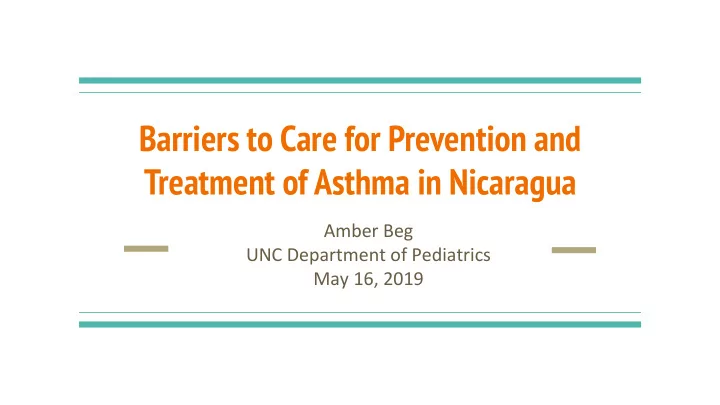

Barriers to Care for Prevention and Treatment of Asthma in Nicaragua Amber Beg UNC Department of Pediatrics May 16, 2019
Asthma ● Common chronic disease globally ● Particularly severe consequences in lower income countries due to lack of resources and physicians for diagnosis and treatment ● Prevalence in asthma in Nicaragua is 15.2%
AMOS Health And Hope Nonprofit focused on improving primary care in Nicaragua ● Founded by Drs. Laura and David Parajon ● Serves 27 communities in 4 departments, offering basic ● healthcare to over 13,000 individuals Health promoters (consejeras) ●
Urban Programs
El Samaritano Medical Clinic Outpatient clinic on outskirts of Managua ● 2 full time general physicians; Pediatrician 1-2 days a week ● Appointments, first-come first-serve, for approximately $2 (80 ● córdobas ) Also has support groups for pregnant women and patients with ● diabetes
Project Overview • Collaboration with AMOS Health & Hope, a non-profit community organization in Managua, Nicaragua • Problem Identified: Asthma is prevalent but under-treated in the communities served by AMOS • Hypothesis: A screening questionnaire administered by community health workers will be effective in case-detection of asthma in a semi-urban, poor Nicaraguan community.
Objectives 1)Determine the prevalence of asthma in community •Via pediatric pulmonologist evaluation •Using spirometry 2)Evaluate the effectiveness of a community health worker-administered asthma screening questionnaire 3)Explore environmental or demographic factors contributing to asthma prevalence
Prevalence of Asthma 65 out of 199 children (33%) ●
Community Health Worker Questionnaire ● Sensitivity: 86% ● Specificity: 75% ● An effective tool in a low resource setting!
Initial Conclusions Feasible for use by lay community health workers after a brief training ● Accurate enough to be effective for case-detection of asthma and reactive ● airways disease. Able to connect children with medical care ●
A Year Later... ● Poor follow up ○ Only 3-4 of patients documented as returning to clinic ● Misunderstanding ○ Community health workers felt that needed a physician to return to community to diagnose asthma ● AMOS didn’t have dedicated funding for the project specifically, community health workers had other responsibilities, project stalled
Barriers to Care
Barriers to Care Questionnaire ● Difficult to find a validated questionnaire in this type of population in literature review ● Wanted to develop more of a qualitative set of interview questions with opportunity for flexibility in answers ● Also wanted demographic information ● Became more of a QI type project
Barriers to Care Questionnaire ● Demographics ● General health of Child ● Knowledge of Asthma ● Severity of asthma ● Medications and Treatments used ● Barriers to Care
Interviews 30 of the 65 pediatric patients ● identified with asthma on initial screening (46%) Spoke with caregivers of patients ● Interviewer, Interpreter, ● consejera Home visits ● Written questionnaire ● documented by interviewer as well as audio recordings (over 900 minutes of interviews)
Results
Demographics
Results Caregivers ● Mothers (84%), Sisters (10%), Grandmother (3%), Grandfather (3%) ○ Employment ● All except 1 had at least 1 family member employed ○ 2 parents employed (60%) ○ 1 parent working (40%) ○ Education ● University- 23% ○ Secondary education- 47% ○ Primary education- 17% ○ Technical education- 10% ○ None- 3% ○
General Health Of Child
Results Current health ● 1 (regular): 50% ○ 2 (bueno): 16.6% ○ 3 (muy bueno): 16.6% ○ 4 (excelente): 16.6% ○ Health compared to a year ago ● 1 (peor): 17% ○ 2 (lo mismo): 3% ○ 3 (mas or menos): 10% ○ 4 (mejor): 70% ○
Knowledge of Asthma
Knowledge of Asthma
Results Has asthma? ● Yes: 70% ○ No: 17% ○ Can be cured? ● Yes: 83.3% ○ No : 13.3% ○ Not sure: 3.3% ○
Results Severity ● 0: 10% ○ 1: 17% ○ 2: 53% ○ 3: 7% ○ 4: 13% ○ Consequences: ● Could die: 63% ○ Go to hospital: 27% ○ Get worse: 10% ○ Not get enough air: 3% ○
Results: Controller medications Knowledge about controller medication: 13.3% ● Use a controller medication: 17% ● 2 used a controller medication but didn’t know that daily medications ● could be used 1 had knowledge of controller medication, but didn’t use ●
Causes of Asthma Exacerbations Dust, change in weather, cold weather, exercise ● Bathing in the afternoon ● 4 patients had notes from physicians saying they couldn’t exercise at ● school Only one person said illness ●
Medications and Treatments used
Results Only 2 didn’t use albuterol ● 5 used controller medications ● Most used prednisone ● Allergy meds ● Claritin ○ Benadryl ○ Ketofino ○ Fluticisone nasal spray ○ Lots of confusion between cold medications and asthma medications ●
Results Spacer ● 23% don’t use ○ 2% had but didn’t use it ○ 75% used ○ Traditional remedies ● Prevalent ○ Not dangerous (eucalyptus tea, lemograss, cinnamon, oregano) ○ Shark oil? ○ Nebulizers ●
Barriers to Care
Results Returned to AMOS ● Yes: 73% (22 patients as opposed to 3-4 patients) ○ Saw a doctor: 57% ○ Had information about asthma in the past? ● No: 40% ○ Yes: 60% ○ From whom? ● Mary: 37% ○ Family members: 13% ○ A doctor: 13% ○ Written information: 3% ○
Results How would you like to receive information: ● Group classes: 80% ○ Written information: 23% ○ Home visits: 20% ○ How can we help? ● Transport: 0% ○ Cheaper visits: 47% ○ Cheaper medications: 90% ○ Home visits: 53% ○ Group classes: 7% ○ Clearer information: 3% ○
Conclusions Expense of visits and medications were a huge barrier to care in the ● population There was more follow up than expected ● Group classes were preferred ●
Acknowledgments Dr. Sylvia Becker-Dreps and ● Dr. Laura Parajon Dr. Mary Crocker ● Consejeras and Staff at ● AMOS
Questions?
Recommend
More recommend